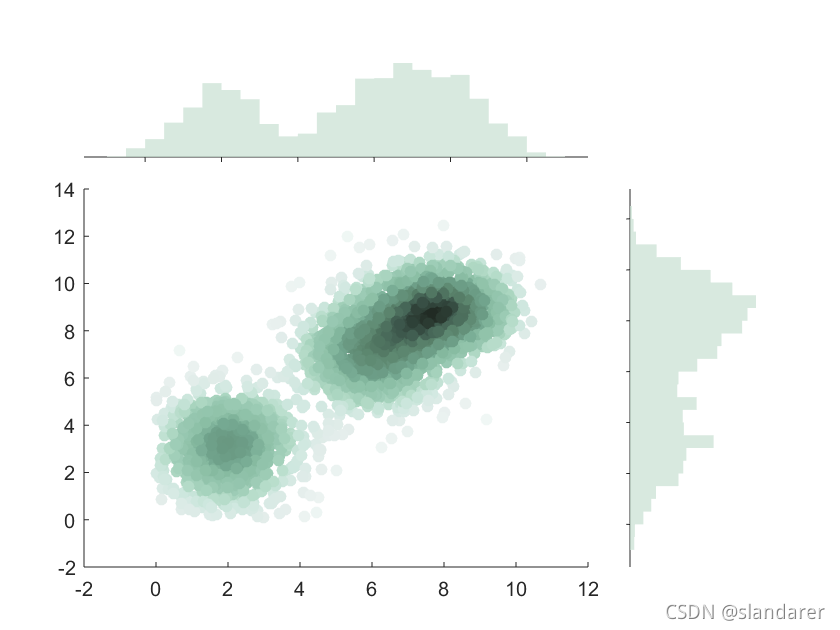
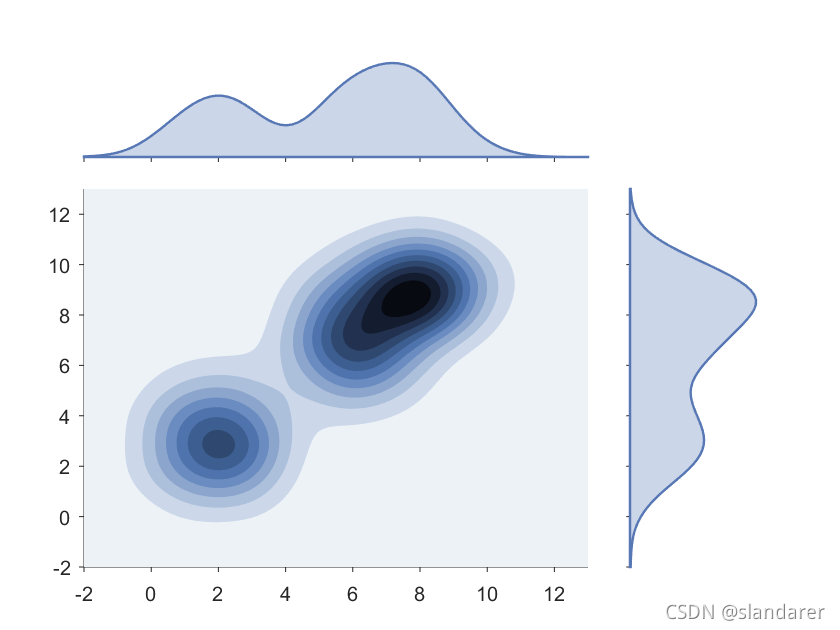

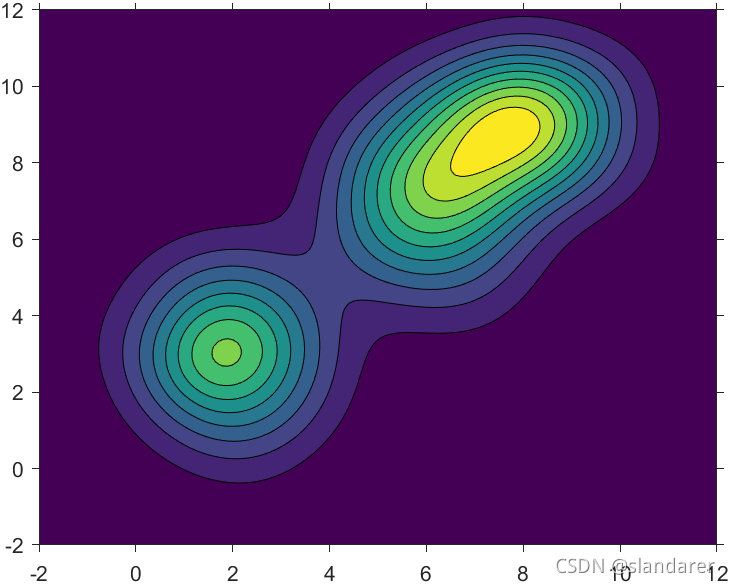
原理也很简单,通过matlab自带的ksdensity获得网格每一点密度,通过密度拟合曲面,再计算每个数据点对应的概率,并将概率映射到颜色即可
为了怕大家找不到函数这次工具函数放到最前面
function [CData,h,XMesh,YMesh,ZMesh,colorList]=density2C(X,Y,XList,YList,colorList)
[XMesh,YMesh]=meshgrid(XList,YList);
XYi=[XMesh(:) YMesh(:)];
F=ksdensity([X,Y],XYi);
ZMesh=zeros(size(XMesh));
ZMesh(1:length(F))=F;
h=interp2(XMesh,YMesh,ZMesh,X,Y);
if nargin<5
colorList=[0.2700 0 0.3300
0.2700 0.2300 0.5100
0.1900 0.4100 0.5600
0.1200 0.5600 0.5500
0.2100 0.7200 0.4700
0.5600 0.8400 0.2700
0.9900 0.9100 0.1300];
end
colorFunc=colorFuncFactory(colorList);
CData=colorFunc((h-min(h))./(max(h)-min(h)));
colorList=colorFunc(linspace(0,1,100)');
function colorFunc=colorFuncFactory(colorList)
x=(0:size(colorList,1)-1)./(size(colorList,1)-1);
y1=colorList(:,1);y2=colorList(:,2);y3=colorList(:,3);
colorFunc=@(X)[interp1(x,y1,X,'pchip'),interp1(x,y2,X,'pchip'),interp1(x,y3,X,'pchip')];
end
end
输入:
输出:
假如编写了如下程序:
PntSet1=mvnrnd([2 3],[1 0;0 2],800); PntSet2=mvnrnd([6 7],[1 0;0 2],800); PntSet3=mvnrnd([8 9],[1 0;0 1],800); PntSet=[PntSet1;PntSet2;PntSet3]; scatter(PntSet(:,1),PntSet(:,2),'filled');
结果:
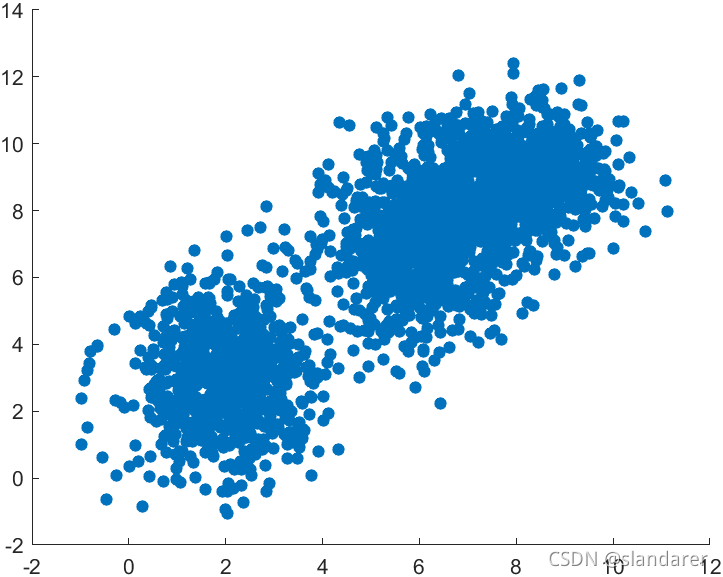
将上面那段代码改写
PntSet1=mvnrnd([2 3],[1 0;0 2],800); PntSet2=mvnrnd([6 7],[1 0;0 2],800); PntSet3=mvnrnd([8 9],[1 0;0 1],800); PntSet=[PntSet1;PntSet2;PntSet3]; CData=density2C(PntSet(:,1),PntSet(:,2),-2:0.1:15,-2:0.1:15); scatter(PntSet(:,1),PntSet(:,2),'filled','CData',CData);
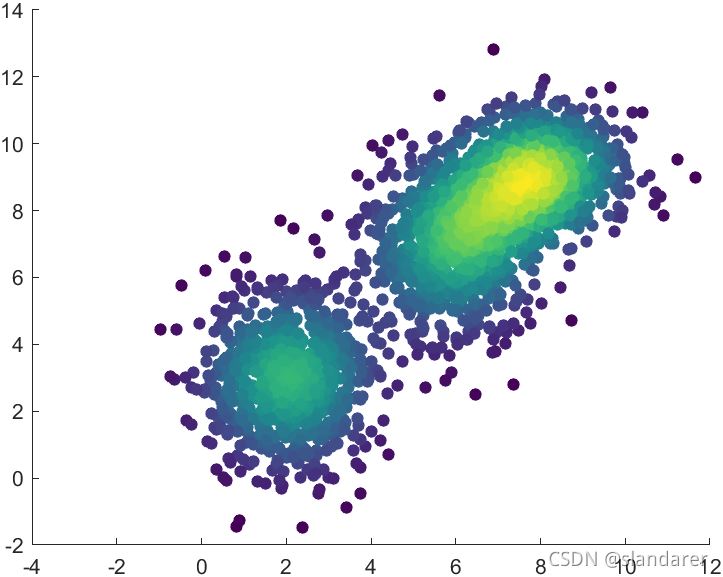
PntSet1=mvnrnd([2 3],[1 0;0 2],800); PntSet2=mvnrnd([6 7],[1 0;0 2],800); PntSet3=mvnrnd([8 9],[1 0;0 1],800); PntSet=[PntSet1;PntSet2;PntSet3]; [~,~,XMesh,YMesh,ZMesh,colorList]=density2C(PntSet(:,1),PntSet(:,2),-2:0.1:12,-2:0.1:12); colormap(colorList) contourf(XMesh,YMesh,ZMesh,10)
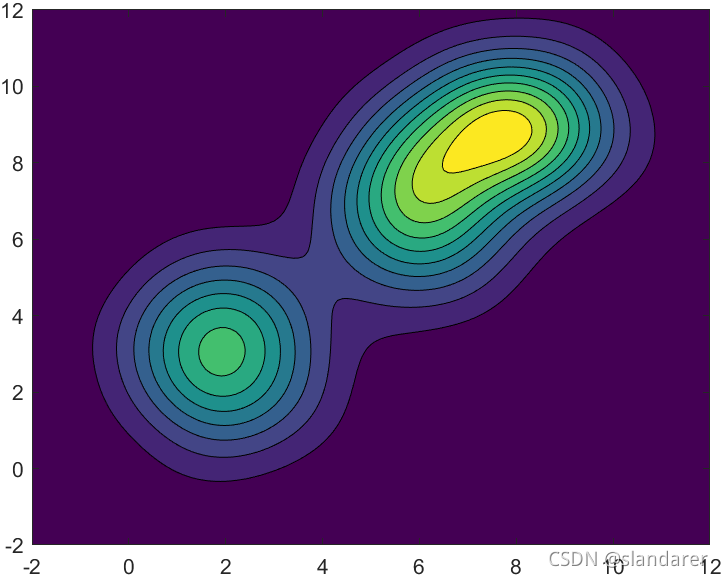
PntSet1=mvnrnd([2 3],[1 0;0 2],800);
PntSet2=mvnrnd([6 7],[1 0;0 2],800);
PntSet3=mvnrnd([8 9],[1 0;0 1],800);
PntSet=[PntSet1;PntSet2;PntSet3];
colorList=[0.9400 0.9700 0.9600
0.8900 0.9300 0.9200
0.8200 0.9100 0.8800
0.6900 0.8500 0.7700
0.5900 0.7800 0.6900
0.5500 0.7500 0.6500
0.4500 0.6500 0.5600
0.4000 0.5800 0.4900
0.3500 0.5100 0.4200
0.2500 0.3600 0.3100
0.1300 0.1700 0.1400];
CData=density2C(PntSet(:,1),PntSet(:,2),-2:0.1:15,-2:0.1:15,colorList);
set(gcf,'Color',[1 1 1]);
% 主分布图
ax1=axes('Parent',gcf);hold(ax1,'on')
scatter(ax1,PntSet(:,1),PntSet(:,2),'filled','CData',CData);
ax1.Position=[0.1,0.1,0.6,0.6];
% X轴直方图
ax2=axes('Parent',gcf);hold(ax2,'on')
histogram(ax2,PntSet(:,1),'FaceColor',[0.78 0.88 0.82],...
'EdgeColor','none','FaceAlpha',0.7)
ax2.Position=[0.1,0.75,0.6,0.15];
ax2.YColor='none';
ax2.XTickLabel='';
ax2.TickDir='out';
ax2.XLim=ax1.XLim;
% Y轴直方图
ax3=axes('Parent',gcf);hold(ax3,'on')
histogram(ax3,PntSet(:,2),'FaceColor',[0.78 0.88 0.82],...
'EdgeColor','none','FaceAlpha',0.7,'Orientation','horizontal')
ax3.Position=[0.75,0.1,0.15,0.6];
ax3.XColor='none';
ax3.YTickLabel='';
ax3.TickDir='out';
ax3.YLim=ax1.YLim;

PntSet1=mvnrnd([2 3],[1 0;0 2],800);
PntSet2=mvnrnd([6 7],[1 0;0 2],800);
PntSet3=mvnrnd([8 9],[1 0;0 1],800);
PntSet=[PntSet1;PntSet2;PntSet3];
colorList=[0.9300 0.9500 0.9700
0.7900 0.8400 0.9100
0.6500 0.7300 0.8500
0.5100 0.6200 0.7900
0.3700 0.5100 0.7300
0.2700 0.4100 0.6300
0.2100 0.3200 0.4900
0.1500 0.2200 0.3500
0.0900 0.1300 0.2100
0.0300 0.0400 0.0700];
[~,~,XMesh,YMesh,ZMesh,colorList]=density2C(PntSet(:,1),PntSet(:,2),-2:0.1:13,-2:0.1:13,colorList);
set(gcf,'Color',[1 1 1]);
% 主分布图
ax1=axes('Parent',gcf);hold(ax1,'on')
colormap(colorList)
contourf(XMesh,YMesh,ZMesh,10,'EdgeColor','none')
ax1.Position=[0.1,0.1,0.6,0.6];
ax1.TickDir='out';
% X轴直方图
ax2=axes('Parent',gcf);hold(ax2,'on')
[f,xi]=ksdensity(PntSet(:,1));
fill([xi,xi(1)],[f,0],[0.34 0.47 0.71],'FaceAlpha',...
0.3,'EdgeColor',[0.34 0.47 0.71],'LineWidth',1.2)
ax2.Position=[0.1,0.75,0.6,0.15];
ax2.YColor='none';
ax2.XTickLabel='';
ax2.TickDir='out';
ax2.XLim=ax1.XLim;
% Y轴直方图
ax3=axes('Parent',gcf);hold(ax3,'on')
[f,yi]=ksdensity(PntSet(:,2));
fill([f,0],[yi,yi(1)],[0.34 0.47 0.71],'FaceAlpha',...
0.3,'EdgeColor',[0.34 0.47 0.71],'LineWidth',1.2)
ax3.Position=[0.75,0.1,0.15,0.6];
ax3.XColor='none';
ax3.YTickLabel='';
ax3.TickDir='out';
ax3.YLim=ax1.YLim;

ggplot风格修饰器:(点击图片跳转链接)
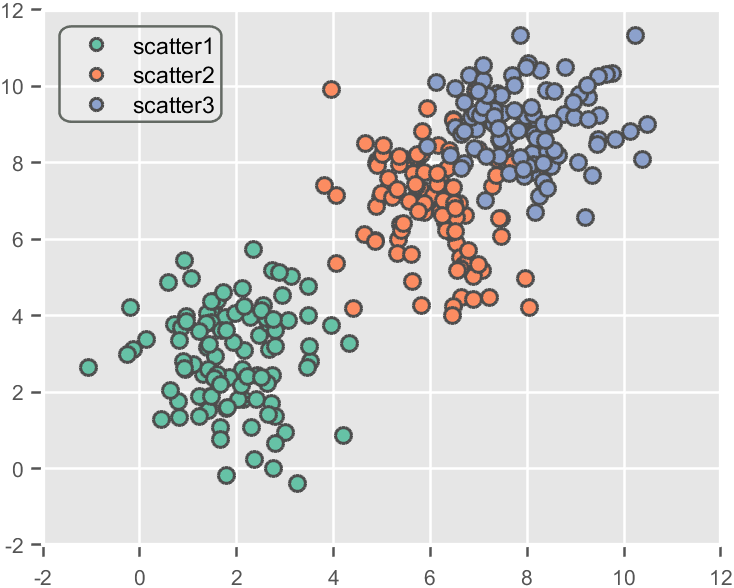
示例1
PntSet1=mvnrnd([2 3],[1 0;0 2],800); PntSet2=mvnrnd([6 7],[1 0;0 2],800); PntSet3=mvnrnd([8 9],[1 0;0 1],800); PntSet=[PntSet1;PntSet2;PntSet3]; ax=gca; ax.XLim=[-1 13]; ax.YLim=[-1 13]; ax=ggplotAxes2D(ax); CData=density2C(PntSet(:,1),PntSet(:,2),0:0.1:15,0:0.1:15); scatter(PntSet(:,1),PntSet(:,2),'filled','CData',CData);
是不是瞬间有那味了:

示例2
PntSet1=mvnrnd([2 3],[1 0;0 2],800); PntSet2=mvnrnd([6 7],[1 0;0 2],800); PntSet3=mvnrnd([8 9],[1 0;0 1],800); PntSet=[PntSet1;PntSet2;PntSet3]; ax=gca; ax.XLim=[-3 13]; ax.YLim=[-3 13]; ax=ggplotAxes2D(ax); [~,~,XMesh,YMesh,ZMesh,colorList]=density2C(PntSet(:,1),PntSet(:,2),-2:0.1:12,-2:0.1:12); colormap(colorList) contourf(XMesh,YMesh,ZMesh,10)
